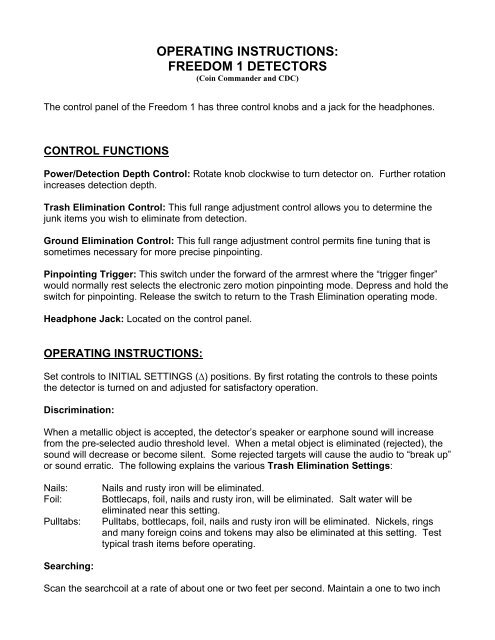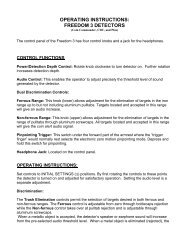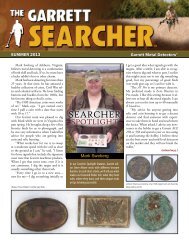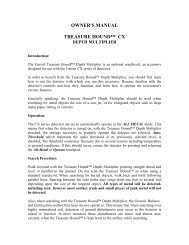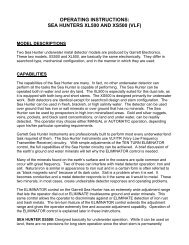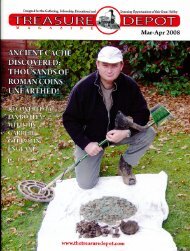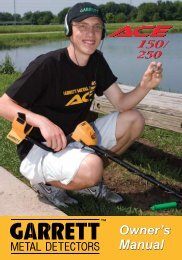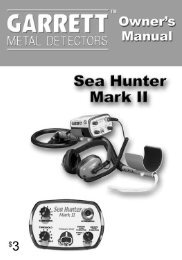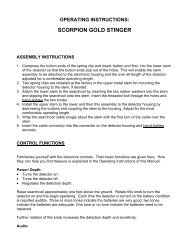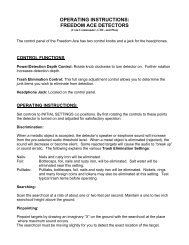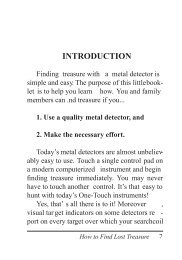Freedom 1 Detectors - Garrett
Freedom 1 Detectors - Garrett
Freedom 1 Detectors - Garrett
Create successful ePaper yourself
Turn your PDF publications into a flip-book with our unique Google optimized e-Paper software.
OPERATING INSTRUCTIONS:FREEDOM 1 DETECTORS(Coin Commander and CDC)The control panel of the <strong>Freedom</strong> 1 has three control knobs and a jack for the headphones.CONTROL FUNCTIONSPower/Detection Depth Control: Rotate knob clockwise to turn detector on. Further rotationincreases detection depth.Trash Elimination Control: This full range adjustment control allows you to determine thejunk items you wish to eliminate from detection.Ground Elimination Control: This full range adjustment control permits fine tuning that issometimes necessary for more precise pinpointing.Pinpointing Trigger: This switch under the forward of the armrest where the “trigger finger”would normally rest selects the electronic zero motion pinpointing mode. Depress and hold theswitch for pinpointing. Release the switch to return to the Trash Elimination operating mode.Headphone Jack: Located on the control panel.OPERATING INSTRUCTIONS:Set controls to INITIAL SETTINGS (∆) positions. By first rotating the controls to these pointsthe detector is turned on and adjusted for satisfactory operation.Discrimination:When a metallic object is accepted, the detector’s speaker or earphone sound will increasefrom the pre-selected audio threshold level. When a metal object is eliminated (rejected), thesound will decrease or become silent. Some rejected targets will cause the audio to “break up”or sound erratic. The following explains the various Trash Elimination Settings:Nails:Foil:Pulltabs:Nails and rusty iron will be eliminated.Bottlecaps, foil, nails and rusty iron, will be eliminated. Salt water will beeliminated near this setting.Pulltabs, bottlecaps, foil, nails and rusty iron will be eliminated. Nickels, ringsand many foreign coins and tokens may also be eliminated at this setting. Testtypical trash items before operating.Searching:Scan the searchcoil at a rate of about one or two feet per second. Maintain a one to two inch
searchcoil height above the ground.Pinpointing:To use the pinpointing function of the detector to determine the exact location, press the“trigger switch” and HOLD. The detector will now give a more pronounced signal when thesearchcoil is held directly above or criss-crossed over the target.Even more precise pinpointing can be obtained by placing the searchcoil on the ground, thenpressing and HOLDING the switch. Slide the coil, maintaining ground contact across thetarget.CONTROLS ADJUSTMENTThis detector has INITIAL SETTING points (∆) located on the control panel. By first rotatingthe controls to these INITIAL SETTING points, you quickly adjust the detector for operationover average ground.The AUDIO on the <strong>Freedom</strong> 1 has been preset at the factory to a level where sound is barelydiscernible when the detector is searching.You may now operate satisfactorily without further adjustment. For optimum performance, asyou become more familiar with your <strong>Freedom</strong> 1, slight (+) or (-) adjustments to the DetectionDepth and Trash and Ground Elimination controls may be necessary.GROUND ELIMINATION:The initial setting of the Ground Elimination control is for average iron minerals, minoradjustments may be necessary for the ground being searched, and particularly for moreprecise electronic pinpointing. Tune this control as follows:1. Hold the searchcoil about three feet above the ground.2. Press the trigger switch down and hold while lowering the searchcoil to two inchesabove ground level.3. Note the audio response. Raise the coil and release the switch.4. If the sound increased, raise the Ground Elimination higher and repeat steps 1through 3. If the sound decreased, the control is set too high. Lower the controlsetting and repeat steps 1 through 3.BATTERIES:The <strong>Freedom</strong> 1 requires three (3) 9-volt batteries.Battery Test:Each time the detector is turned on the batteries are automatically and audibly checked. Threetones indicate the batteries are very good, two tones and the batteries are adequate. Onesingle tone and it is time to replace the batteries.Battery Replacement:
The batteries are located on the side of the chassis of <strong>Freedom</strong> 1 inside the control housing.To reach them disconnect the searchcoil cable and loosen the captive thumbscrew beneaththe control housing. Press on the searchcoil connector to loosen the chassis and carefully slideit out. The batteries are beneath a protective clamp directly behind the control panel. Loosenthe screw holding it and slide the clamp off to allow removal of the batteries.MAINTENANCE Always remember that your detector is a sensitive electronic instrument. It is built towithstand rugged treatment in the outdoors. Use your <strong>Garrett</strong> detector to the fullest extentpossible, and never feel that you have to baby it. Yet, always protect the detector andhandle it with reasonable care. Try to avoid temperature extremes as much as possible, such as storing the detector in anautomobile trunk during hot summer months or outdoors in sub-freezing weather. Keep you detector clean. Always wipe the housing after use, and wash the coil whennecessary. Protect your instrument from dust and sand as much as possible. Your searchcoil is submersible. The control housing is not! Never submerge the controlhousing and always protect it from heavy mist, rain or blowing surf. Disassemble the stem and wipe it clean after use in sandy areas. When storing longer that about one month, remove batteries from the detector.REPAIR SERVICE In case of difficulty, read this Owner’s Manual again thoroughly to make certain yourdetector is not inoperable needlessly. Your dealer may also be able to offer advice. When your detector must be returned to the factory for service, always include a letter thatdescribes its problem as fully as possible. Before you return your detector to the <strong>Garrett</strong>factory, make certain: You have checked batteries, switches and connectors. (Check batteries especially closely.They are the most common cause of detector “failure”.) You have checked with your dealer, particularly if you are not familiar with this typedetector. You have included a note with the detector describing the problems you are encounteringwith this detector and conditions under which they occur. Make certain to include yourname, address and a phone number where you can be contacted between 8:30 a.m. and 4p.m., Central Time. You have carefully packed the detector in its original shipping carton or other suitable box.Make certain that proper insulation or packing material is used to keep all parts secure. Do
not ship stems or headphones unless they are part of the problem. Be certain to return allcoils. Ship to <strong>Garrett</strong> Metal <strong>Detectors</strong>, 1881 W. State St., Garland, TX 75042. You can call <strong>Garrett</strong>’s Customer Service Department (800-527-4011) if you have furtherquestions. Please allow approximately one week for <strong>Garrett</strong> technicians to examine and repair yourdetector after they receive it, plus another week for return shipping to you. All equipmentwill be returned UPS or parcel post unless written authorization is given by you to shipcollect by air parcel post, UPS Blue (air) or air freight.MIND YOUR MANNERSFilling holes and obeying no trespassing signs are but two requirements of a dedicated metaldetector hobbyist. A sincere request that Charles <strong>Garrett</strong> makes to every user of one of hisdetectors is that each place searched be left in a better condition than it was found.Thousands of individuals and organizations have adopted this formal Metal Detector OperatorsCode of Ethics: I will respect private and public property, all historical and archaeological sites and will dono metal detecting on these lands without proper permission. I will keep informed on and obey all laws, regulations and rules governing federal, state andlocal public lands. I will aid law enforcement officials whenever possible. I will cause no willful damage to property of any kind, including fence, signs and buildingsand will always fill holes I dig. I will not destroy property, buildings or the remains of ghost towns and other desertedstructures. I will not leave litter or uncovered items lying around. I will carry all trash and dug targetswith me when I leave each search area. I will observe the Golden Rule, using good outdoor manners and conducting myself at alltimes in a manner which will add to the stature and public image of all people engaged inthe field of metal detection.WARNING!Any metal detector may discover underground power lines, explosives or other items whichwhen struck could cause personal injury. When searching for treasure with your detector,observe these precautions:
Do not hunt in an area where you believe there may be shallowly buried undergroundelectric lines or pipes. Do not hunt in a military zone where bombs or other explosives may be buried. Avoid striking any line known to be or suspected to be carrying electrical power. Do not disturb any pipeline, particularly if it could be carrying flammable gas or liquid. Use reasonable caution in digging toward any target, particularly in areas where you areuncertain of underground conditions.PATENT PROTECTION: Proof of <strong>Garrett</strong> excellence is the recognition given them by the followingUnited States patents: 4,709,213; 4,488,115; 4,700,139; 4,398,104; 4,423,377; 4,303,879; 4,334,191;3,662,255; 4,162,969; 4,334,192; 5,148,151; 5,138,262; 5,721,489; 5,786,696; 5,969,528; Design274,704 and 297,221; Design 333,990; G.B. Design 2,011,852; Australia Design 111,674 and otherpatents pending


